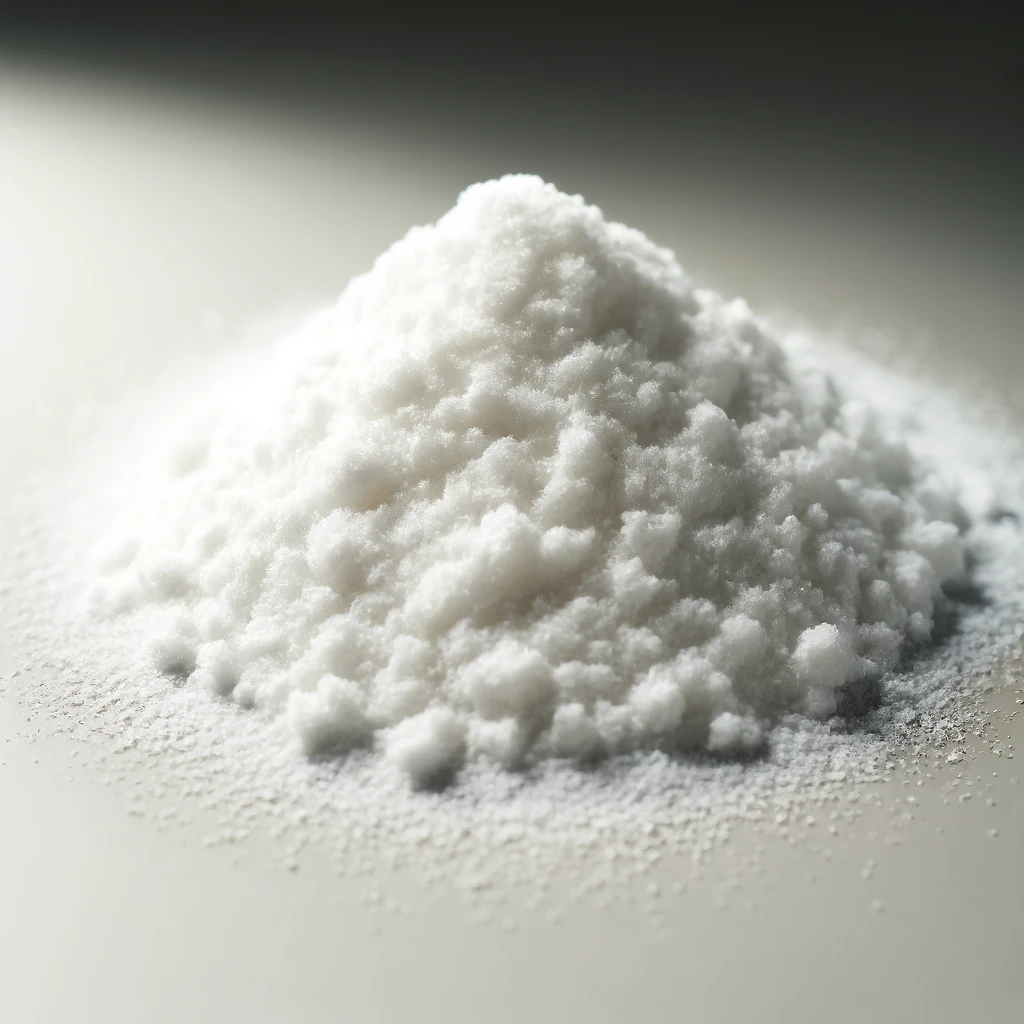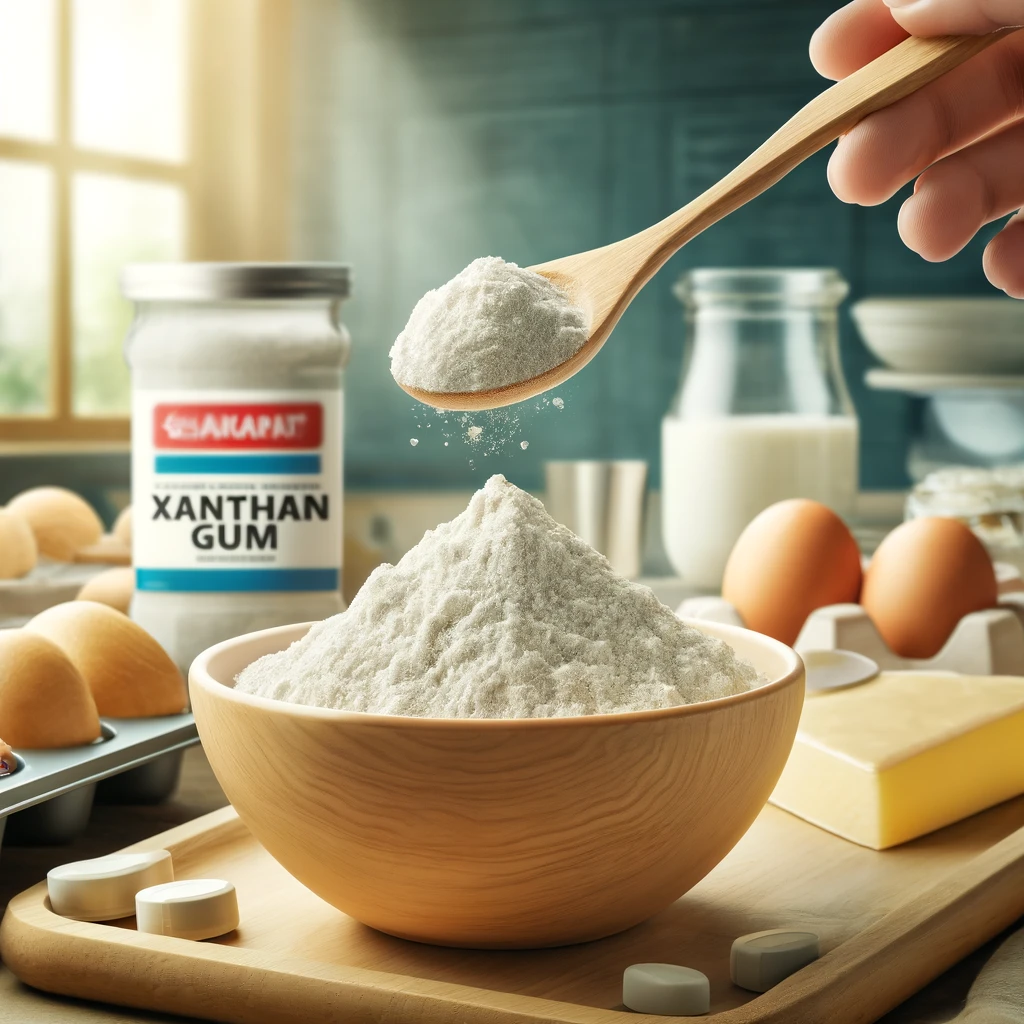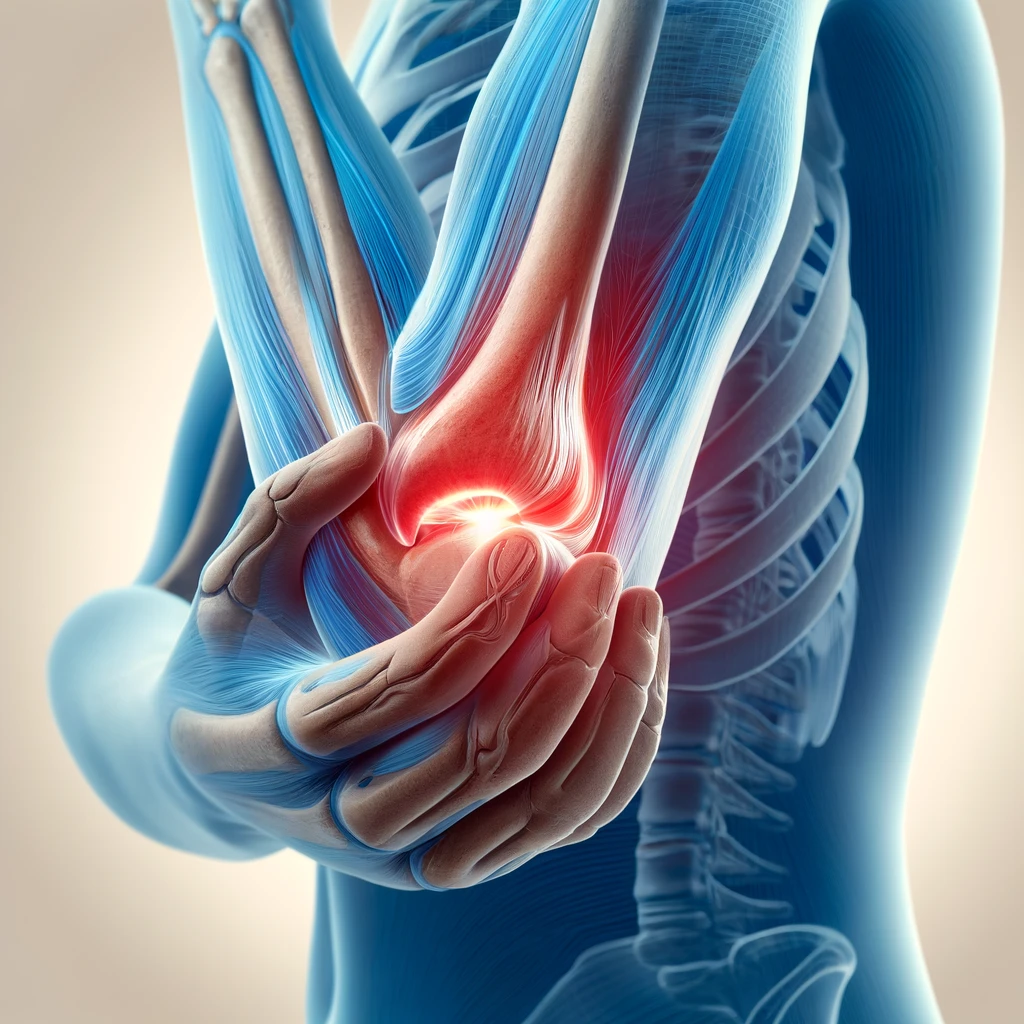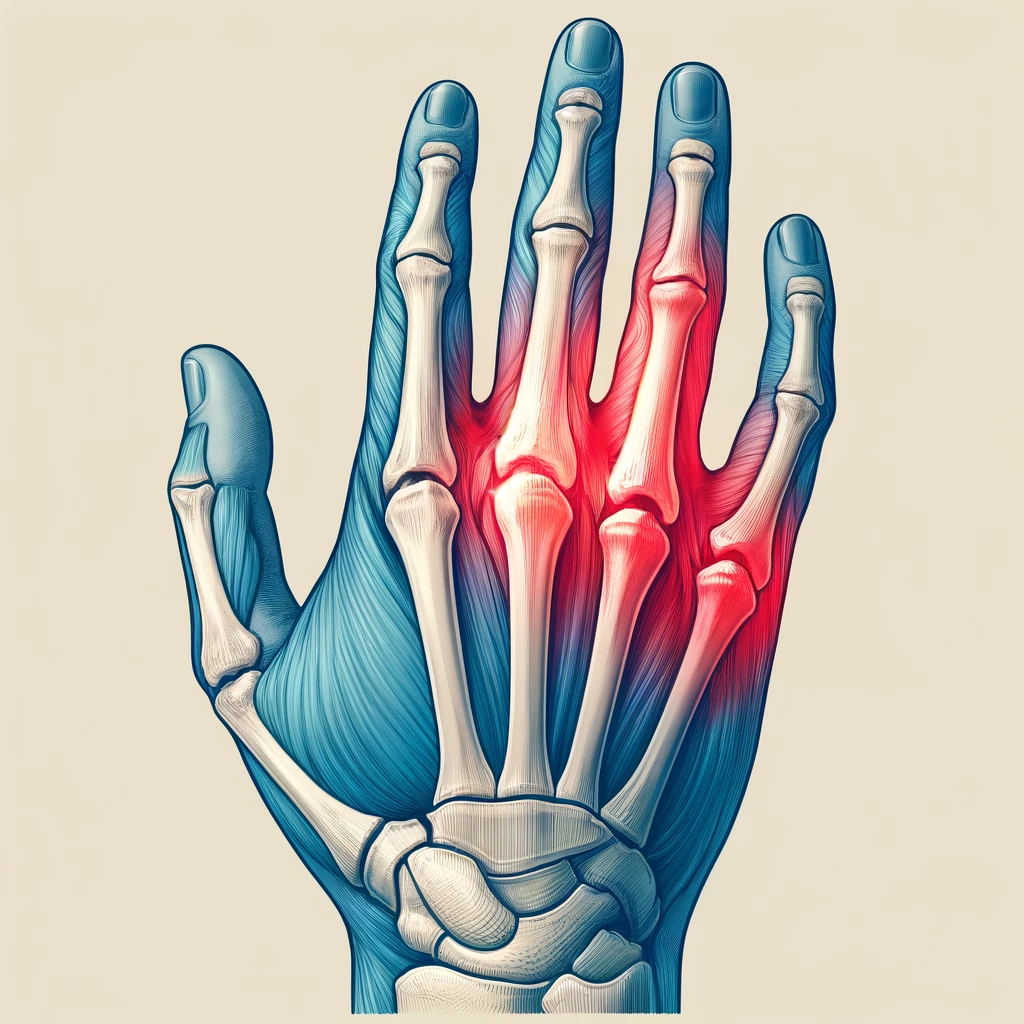
Xanthan Gum
Introduction to Xanthan Gum.
Xanthan gum is a special kind of powder that does a great job of making things thicker and helps them stick together. It works a bit like how flour mixes with water to form dough, but xanthan gum is used in many more things besides just cooking. To make xanthan gum, scientists let tiny bacteria grow on a sugar mix until it transforms into this useful powder.
This powder is really popular because it’s effective and safe to eat. You might even find it in foods you have at home like salad dressings and ice cream! Xanthan gum is super useful because it can mix well with both water and oil, even though they usually don’t like to mix. This helps to keep things like dressings and sauces from separating.
What’s really cool about xanthan gum is that it makes foods and other products feel smooth and creamy, and it helps them last longer without going bad. For example, in salad dressings, it keeps the oil and vinegar mixed together instead of splitting apart. Because it is so good at doing these jobs, many companies add xanthan gum to their products to make them better.

Definition and Basic Information: What is xanthan gum and where does it come from?
Xanthan gum is made by a tiny germ called Xanthomonas campestris. This little germ likes to eat sugar, and when it does, it produces xanthan gum. This might sound a bit yucky, but it’s actually a very clean and safe process. After the germ makes the xanthan gum, it is dried into a powder that doesn’t smell or taste like anything.
This powder is really good at making liquids thicker. For example, if you add a little xanthan gum to water, it turns into a gooey mixture. This is why people like to use it in cooking and making various products where they need a thick liquid.
Even though it comes from germs, xanthan gum is completely safe to use. Scientists and food safety experts check to make sure it’s good to use in food and other products. So, we can use it without worrying about it being bad for our health.
Common Uses: Overview of its uses in various industries like food, cosmetics, and pharmaceuticals.
Xanthan gum is like a magic ingredient that you can find in many different things. In food, it helps keep ice cream smooth and prevents ice crystals from forming. It also helps thicken sauces and keeps salad dressings mixed.
In cosmetics, which are things like lotions and shampoos, xanthan gum makes these products creamier and easier to spread on your skin or hair. It helps the lotions stay mixed and not separate into watery and oily parts. This makes them nice to use and helps them work better.
Xanthan gum is also used in medicines, especially in the liquid ones. It helps the medicine stay mixed properly so that each spoonful has the right amount of medicine. This makes it very important for making sure the medicine works the way it should every time you take it.
Importance: Why xanthan gum is valued for its properties and the benefits it offers in formulations.
Xanthan gum is a clever powder made by a tiny germ called Xanthomonas campestris. This little germ loves to munch on sugar 🍬, and as it eats, it creates xanthan gum. Though it might sound a bit strange, this process is actually very clean and safe! After the germ makes the xanthan gum, it’s dried into a powder that doesn’t have any smell or taste.
This magical powder is awesome at thickening liquids. For example, if you sprinkle a little xanthan gum into water, it turns into a gooey, slime-like mixture 🧪. This cool trick is why so many people use it in cooking and in making various products where a thick liquid is needed.
Even though xanthan gum comes from germs, it’s completely safe to use. Scientists and food safety experts carefully check it to make sure it’s perfect for food and other products 🥣. So, we can enjoy using it without worrying about it being harmful. It helps make many of our favorite foods better and even more fun to eat!
Chemical Composition of Xanthan Gum.
Xanthan gum might seem like just a simple powder, but it’s made up of some interesting stuff! 🧐 When scientists look closely, they find that xanthan gum is made from sugar molecules that are all stuck together in a special way. This sticking together makes the powder really good at thickening things up when it’s mixed with liquids.
The main ingredients in xanthan gum come from natural sugars, just like the ones found in your kitchen. These sugars are transformed by the Xanthomonas campestris germ, which turns them into a sticky, stringy goo during the process. This goo is what dries up to become the powdery xanthan gum we use. 🍬➡️🧫➡️🍚
Because of its unique makeup, xanthan gum can do things that other thickeners can’t. It can hold water and oil together, which is super helpful in foods like salad dressing or sauces. This makes xanthan gum a superstar ingredient in kitchens and factories around the world! 🌍✨ Whether you’re making a cake that needs to be extra moist or a dressing that shouldn’t separate, xanthan gum is there to save the day!
Molecular Structure: Discussion of its unique polysaccharide structure.
Xanthan gum is made up of something called polysaccharides, which might sound super scientific, but they’re actually just big, fancy sugar molecules stuck together. 🍬 Think of it like building a tower, but instead of using blocks, you’re stacking up sugar! These sugars come together in a special pattern that makes xanthan gum really good at its job—like turning thin liquids into thick, gooey mixtures.
This unique pattern of sugars is why xanthan gum can do some amazing tricks that other ingredients can’t. It acts like a superhero in the kitchen, helping to make things thick and smooth without changing their taste. 🦸♂️ Whether it’s making a milkshake creamier or a sauce thicker, xanthan gum is the secret ingredient that does the magic.
What’s really cool about xanthan gum is that it works under different conditions. It doesn’t matter if it’s hot or cold; xanthan gum still does its job. 🌡️☃️ This makes it a favorite for chefs and food makers all around the world. From homemade treats to store-bought goodies, xanthan gum helps make sure everything comes out just right!
Production Process: How xanthan gum is produced using microbial fermentation.
Xanthan gum is created by tiny microbes that act like mini-factories. 🏭 These little workers are called Xanthomonas campestris, and they have a big appetite for sugar. When scientists feed them sugar in a lab, these microbes get to work and produce xanthan gum as a kind of waste. Yes, even waste can be super useful! This whole process is called fermentation, which is similar to how bread rises when yeast eats sugar. It’s like watching a science magic show right in the lab! 🧪🎩
During fermentation, these microbes turn the sugar into xanthan gum by spinning it into long, sticky chains. These chains are what make xanthan gum so great at thickening and stabilizing foods. Just a little bit of this gum can turn a runny liquid into something thick and gooey, perfect for making sauces cling to your spaghetti or keeping your ice cream smooth and creamy. 🍦🍝
What’s really neat is that xanthan gum can be used in so many different ways. From baking goodies to crafting perfect salad dressings, it helps everything stay just the right texture. And since it’s made in such a clean and controlled way, it’s completely safe to eat. So, next time you enjoy a thick smoothie or a hearty soup, remember the tiny microbes and their magic show that helped make it just right! 🥣🥤
Key Properties: Intrinsic properties such as solubility and viscosity.
Xanthan gum has some cool tricks up its sleeve! 🎩✨ It’s really good at dissolving in water, which means it can mix well without leaving any lumps. This superpower is called solubility. Just sprinkle some xanthan gum into water, and it disappears, mixing in smoothly. This makes it perfect for cooking and baking because it blends so easily and doesn’t make things gritty or lumpy.
It’s also very viscous, which is a fancy word for being thick and sticky. 🍯 Thanks to its viscosity, xanthan gum can make liquids thicker. This is super helpful when you’re making shakes, sauces, or even yummy dressings. With just a little bit of xanthan gum, these foods can have the perfect texture—neither too runny nor too gloopy. It’s like having a magic wand in the kitchen that adjusts everything to be just right!
What’s awesome about xanthan gum is that it works in both hot and cold dishes. Whether you’re whipping up a hot soup or a cold smoothie, xanthan gum can step in to make sure everything stays nicely mixed and wonderfully thick. 🍲🥤 So, next time you sip on a shake or scoop up some sauce, think about the xanthan gum working its magic to make every bite or sip just perfect!

Role of Xanthan Gum in Food Industry.
Xanthan gum plays a super important role in the food industry, almost like a behind-the-scenes superhero! 🦸♂️🍽 It’s added to lots of different foods to help them keep their shape and texture. Think about a creamy salad dressing or a thick chocolate milkshake; xanthan gum helps them stay just the way you like them, without separating or getting watery.
This amazing ingredient also helps foods travel better, from factories to your fridge, without changing how they look or taste. 🚚🍦 Imagine buying a tub of ice cream and finding it all icy and hard instead of smooth and creamy. Xanthan gum prevents that from happening by keeping the ice cream nice and soft, even after it’s been in the freezer for a while.
Plus, xanthan gum is great for people with different dietary needs. It’s gluten-free, which is super helpful for people who can’t eat gluten because of allergies or health reasons. 🌾➡️🚫 It also works in vegan recipes as a substitute for eggs, helping mix ingredients together in cakes and cookies. So, xanthan gum is not just good at its job; it’s also a friend to many, making sure everyone can enjoy delicious and perfectly textured food!

Thickening Agent: How it stabilizes and thickens food products.
Xanthan gum is like a magic spell for making things thick! 🧙✨ When you sprinkle a little bit into foods, it turns them from watery to wonderfully thick. Imagine adding flour to soup to make it creamier; xanthan gum does the same thing, but you only need a tiny pinch. It’s so powerful that even a small amount can transform a liquid into a thick sauce or a perfect pudding. This makes it super handy in the kitchen because it helps foods have just the right texture that feels good in your mouth.
This magical powder doesn’t change the flavor of foods, which is really cool. 🚫👅 You can add it to all sorts of dishes, like smoothies, soups, and even baking recipes, and it won’t mess with the taste. This means you can enjoy your favorite flavors just the way you like them, but with a better, thicker texture. It’s especially great for making gluten-free recipes thicker without needing flour, which is a big win for people who can’t eat gluten!
Not only is xanthan gum awesome for cooking at home, but it’s also a star in restaurants and food factories. 🍽️🏭 Chefs and food makers love it because it helps keep dishes consistent every time they’re made. Whether it’s keeping salad dressings mixed or making sure dessert jellies hold their shape, xanthan gum is there to make every bite perfect. So, next time you enjoy a thick milkshake or a creamy dip, remember the magic of xanthan gum that made it just right!
Emulsifying Properties: Its role in keeping ingredients emulsified.
Have you ever noticed how oil and vinegar in a salad dressing don’t like to mix? They separate like they’re mad at each other! 😡🥗 Xanthan gum plays the peacemaker and helps them get along. By acting as an emulsifier, it grabs onto both the oil and the water and holds them together so they can’t separate. This means your salad dressing stays mixed and ready to pour, instead of splitting into layers. It’s like xanthan gum gives them a big, friendly hug! 🤗
This cool ability makes xanthan gum super useful in lots of foods, not just salad dressings. Imagine trying to enjoy a sauce or a shake, and it keeps separating while you eat it. Not fun, right? 🙅♂️🍦 With xanthan gum, everything stays smooth and combined, just the way it should be. It’s like having a little kitchen helper who makes sure your food is always looking and tasting its best.
So, the next time you shake up a bottle of dressing or stir a pot of sauce and it stays just perfect, you can thank xanthan gum for keeping peace in your food! It makes sure everything mixes well and stays that way, so every bite is as good as the last. Xanthan gum isn’t just a food ingredient; it’s a little hero that keeps your meals delicious and hassle-free! 🌟👨🍳
Application Examples: Specific examples in products like salad dressings, sauces, and gluten-free baking.
Xanthan gum is a superhero in the kitchen! 🦸♂️ In salad dressings, like we talked about, it keeps the oil and vinegar mixed up, so they don’t separate into different layers. It acts like a friendly glue that makes sure every part of your dressing stays together, ready for your salad. This means you get the perfect mix of flavors in every bite, without any oily patches or too much tang from the vinegar.
In sauces, xanthan gum does another amazing job. It makes them thick and yummy, so they cling to your pasta just right. 🍝 Instead of a watery sauce that runs off your spaghetti, xanthan gum helps it stick to every noodle, giving you more flavor with each forkful. Whether it’s a tomato sauce or a creamy Alfredo, xanthan gum makes sure it’s smooth and delicious.
And in gluten-free baking, where regular flour (that usually makes things stick together) isn’t used, xanthan gum steps in. 🍰 It helps hold everything together so that gluten-free cakes and cookies don’t crumble apart when you take a bite. Gluten-free bakers really love xanthan gum because it helps make their treats just as good as other baked goods! Whether you’re enjoying a slice of cake or a cookie, xanthan gum ensures that each treat is just as delightful and held together as those made with gluten.

Xanthan Gum in Personal Care Products.
Xanthan gum isn’t just a kitchen superstar; it’s also a hidden hero in many personal care products! 🌟 When you squeeze out a dollop of your favorite shampoo or body wash, have you noticed how it’s perfectly thick and not watery? That’s xanthan gum working its magic. It helps these products stay thick and creamy, so they’re easier to spread on your hair or skin. This makes them feel luxurious and effective, giving you that awesome, clean feeling every time.
In lotions and creams, xanthan gum is just as important. 🧴 It acts like a friendly binder that holds all the ingredients together. This ensures that the cream doesn’t separate into oily and watery parts, keeping the texture smooth and pleasant. So when you rub lotion on your skin, it’s delightfully consistent and hydrates your skin beautifully without any greasy residue. Xanthan gum makes your skincare routine feel extra special, leaving your skin soft and nourished.
Even in toothpaste and makeup, xanthan gum plays a vital role. 🦷💄 It helps toothpaste stay thick so it can effectively clean your teeth and protect them from cavities. In makeup, like foundation or liquid lipstick, xanthan gum helps keep the color and other ingredients well mixed, so the application is flawless and long-lasting. Thanks to xanthan gum, these products work better and make you look and feel great! It’s truly a versatile ingredient that enhances many of the personal care items we use every day.
Cosmetic Applications: Usage in lotions, creams, and shampoos.
Xanthan gum is not just for food; it’s also a superstar in things like lotions, creams, and shampoos! 🌟 When it’s added to these products, it helps them become nice and thick, so they’re easy to squirt out of bottles and spread on your skin or hair. Imagine squeezing a bottle of lotion and it runs out too fast – xanthan gum prevents that! It makes sure your lotion comes out just right, not too runny and not too thick. This makes using your favorite products a breeze and a lot less messy!
In shampoos and hair conditioners, xanthan gum has a special job too. 🧴 It helps these products cling to your hair better, so they can work their magic without sliding right off. With xanthan gum, shampoos and conditioners stay on your hair long enough to clean it deeply and condition it, making your hair look shiny and healthy. This ingredient ensures you get all the benefits from your hair care products with every single wash!
And when it comes to skin care, like in your body washes or face cleansers, xanthan gum is there to help too! 🛁 It keeps everything mixed properly so that all the soothing ingredients stay together. This means every time you use your cleanser or body wash, you get the full effect of its moisturizing and cleansing properties. Plus, xanthan gum makes these products feel silky and luxurious, adding a touch of spa-like indulgence to your daily routine. So next time you enjoy your skincare, remember, xanthan gum helps make it extra special!
Benefits for Skin and Hair: The moisturizing and texture-enhancing effects of xanthan gum.
Xanthan gum is great for your skin and hair too! 🌟 It plays a big role in keeping your lotions and creams just the right consistency, which helps them keep your skin hydrated. When you smooth these products over your skin, they leave it feeling super soft and smooth. That’s because xanthan gum locks in moisture, preventing dryness and keeping your skin looking healthy and vibrant. Every time you use a lotion or cream with xanthan gum, you’re giving your skin a little extra care!
In hair products, xanthan gum works wonders as well. 🧴 It helps your hair stay moist and manageable, so you can say goodbye to tangles and frizzy days. Whether it’s a shampoo, conditioner, or a hair styling product, xanthan gum ensures that your hair gets a gentle treatment, making it easier to comb and style. It’s like having a tiny helper in each bottle that works to keep your hair looking its best, no matter what the weather outside is doing!
Plus, xanthan gum can make these products feel silky, which is really nice when you’re spreading them on. 🎀 This silky feeling makes using skin and hair care products a more luxurious experience. Imagine your daily routine being as fun as a mini spa day, all thanks to xanthan gum! So, not only does xanthan gum make products better, but it also makes you look and feel great. Every application is a step toward looking fabulous, with xanthan gum helping all the way!
Formulation Advantages: How it improves product stability and application.
One of the coolest things about xanthan gum is how it helps personal care products stay mixed properly. 🌟 Without it, ingredients in lotions or shampoos might separate, leaving you with some watery parts and some oily parts when you try to use them. This could make using your favorite products a bit frustrating because they wouldn’t work as well. But thanks to xanthan gum, everything stays mixed evenly, so every squeeze is just as good as the last. You get the perfect blend every time you use it!
Xanthan gum also plays a big role in keeping these products stable. 🛡️ This means that lotions, creams, and shampoos don’t just stay mixed; they also keep their texture and effectiveness over time. Whether it’s sitting on a store shelf or waiting in your bathroom cabinet, xanthan gum helps ensure that your personal care products remain fresh and ready to use. This makes xanthan gum a super important ingredient for product quality and customer satisfaction.
Moreover, xanthan gum helps products last longer on the shelf, so you don’t have to worry about them going bad too quickly. 🕒 By improving their shelf life, xanthan gum saves you money and reduces waste, because you don’t need to replace your products as often. Whether you’re using a face wash, body lotion, or hair gel, xanthan gum is working behind the scenes to make sure they’re always at their best. So, next time you enjoy your smooth and effective personal care products, remember that xanthan gum is to thank for that consistent, quality experience!

Xanthan Gum in Pharmaceutical Applications.
Xanthan gum isn’t just useful in foods and personal care products; it’s also a star in the world of medicine! 🌟 In pharmaceutical applications, xanthan gum helps make medicines easier to take. For example, it thickens liquid medicines so they don’t run off your spoon too quickly, and it makes sure every dose is just right. This is super helpful, especially for kids who might find it tough to swallow pills. With xanthan gum, taking medicine becomes a little easier and a lot less messy!
In addition to making medicines thicker, xanthan gum also ensures that the active ingredients in medications are evenly distributed. 🚑 This means that each spoonful of medicine has the same amount of healing power, which is crucial for getting better. Xanthan gum acts like a tiny superhero, making sure that every dose is as powerful as it needs to be. So, whether it’s a cough syrup or a digestion aid, xanthan gum helps it work effectively and safely.
Xanthan gum also plays an important role in creating time-release pills. 🕒 These are special pills designed to release medicine slowly into your body over time, instead of all at once. This helps keep the medicine’s effects lasting longer, which is very helpful for managing symptoms without taking more pills than necessary. Xanthan gum helps these pills keep their shape and release medicine at just the right pace, making sure you get the right treatment throughout the day or night. Thanks to xanthan gum, taking medicine can be more effective and less of a hassle!
Drug Delivery Systems: Its use in tablets and solutions for controlled release.
Xanthan gum has a very important job in medicines, especially in tablets and liquid solutions. 💊 It helps control how fast medicine is released into your body. This means that instead of getting a big rush of medicine all at once, xanthan gum helps it come out slowly so it can work better and longer. Just like a slow drip of water to a plant, xanthan gum makes sure the body gets what it needs over time, helping you feel better more steadily!
This gradual release is really important for keeping your body comfortable and stable as it heals. 🌱 When medicine is released slowly, it means you won’t have big ups and downs in how you feel. Xanthan gum ensures that the medicine’s effects are smooth and consistent, which is much better for treating things like pain or chronic conditions. It’s like having a careful nurse who makes sure you get just the right amount of medicine at the right time.
Moreover, xanthan gum makes taking medicine easier and more pleasant. In liquid medicines, it thickens the solution, which can make the medicine taste better and be less messy to take. 🥄 No more spills or bad-tasting drips! It’s another way xanthan gum helps out, making sure that not only the medicine works well but also that it’s easy to take. So next time you take a spoonful of medicine, you can thank xanthan gum for making it just right for your body!
Excipient Roles: How xanthan gum acts as a binder and stabilizer in medication formulations.
In the world of medicine, xanthan gum also plays the role of a helper, keeping everything together. 🌟 Think of it as glue that holds all the ingredients in a pill together. Without xanthan gum, pills could fall apart or separate into layers. Just like glue keeps your art projects from falling apart, xanthan gum keeps the pills you take strong and intact. This is super important because it ensures that every pill is just as effective as the last, making your treatment reliable and consistent.
Xanthan gum also keeps the medicine stable, which means it helps the medicine stay the same from the time it’s made until the time you take it. 🕒 Stability is key in medicine because it affects how well a medicine can treat your illness. Xanthan gum acts like a protector, guarding the medicine against changes in temperature, moisture, and other conditions that could make it less effective. It’s like having a tiny shield around each pill, making sure it’s ready to work perfectly when you need it.
This stabilizing effect is crucial to make sure every pill works exactly how it’s supposed to! 🛡️ By preventing any changes in the pill’s composition, xanthan gum ensures that each dose you take is just right, helping you get better in the most effective way. It’s like having a dependable friend in your medicine cabinet, making sure that your health is taken care of. Thanks to xanthan gum, you can feel confident that your medicine will do its job just as the doctors intended!
Benefits in Topical Medications: Enhancing the consistency and efficacy of creams and gels.
When it comes to creams and gels that you apply to your skin, xanthan gum is there to make them just right. 🌟 It acts like a special thickener, turning runny liquids into creamy textures that are easy to spread over your skin. This is super helpful because it makes these medications stick to the skin where the medicine is needed most. Instead of dripping off or getting wiped away too easily, the cream stays put, allowing the medicine to work effectively and help heal areas that hurt.
Xanthan gum also ensures that these creams and gels feel nice when you apply them. 🧴 Instead of being sticky or greasy, which can be pretty yucky, it makes the creams feel smooth and pleasant. This makes using them a much nicer experience, especially if you need to use them often. It’s important for medicine to work well, but it’s also great when it feels good to use. Xanthan gum helps with both, making sure the medicine not only helps you heal but also is enjoyable to apply.
Plus, xanthan gum helps these creams and gels do their job better. 🚑 By keeping the texture consistent, it ensures that the active ingredients are evenly distributed throughout the product. This means every bit of cream you apply has the same amount of medicine, helping you get better faster and more effectively. Whether it’s a rash, a muscle ache, or any skin irritation, xanthan gum helps your treatment work evenly and efficiently, so you can feel better sooner!

Health Benefits and Nutritional Value.
When we talk about health benefits and nutritional value, it’s like exploring a treasure chest full of goodies that help our bodies stay strong and healthy! 🌟 Every food we eat has different treasures like vitamins, minerals, and other nutrients that do all sorts of amazing jobs inside us. For example, fruits and vegetables are packed with vitamins that help our eyes see better and our skin stay smooth. Milk and cheese are full of calcium, which makes our bones tough like a superhero’s! 🦸♂️
Eating a variety of foods is important because just like a puzzle needs different pieces to be complete, our bodies need different types of nutrients to work properly. 🧩 Proteins, found in meats and beans, are like the building blocks that help build and repair our muscles. Carbohydrates, found in bread and pasta, give us energy to run, play, and learn. Fats are also important (yes, we need some fats too!), as they keep us warm and protect our organs. Each nutrient has a special role, making sure every part of our body functions as it should.
Lastly, drinking plenty of water is super important too! 💧 Water doesn’t have vitamins or minerals, but it’s essential for keeping us hydrated and making sure all the nutrients we eat can travel around our body to where they’re needed. Just like plants need water to grow, we need water to stay healthy and energetic. Remember, making smart food choices and drinking lots of water will help you grow strong and stay active, so you can play, learn, and have fun every day!
Dietary Fiber: Discussing xanthan gum as a source of soluble fiber.
Xanthan gum is a special type of fiber called soluble fiber, which means it dissolves in water. 💧 When you eat foods with xanthan gum, it turns into a gel-like substance in your stomach. Imagine it like a tiny sponge in your tummy that soaks up water and puffs up! This helps you feel full and satisfied after meals, so you won’t feel hungry again too soon. It’s a clever way to help manage how much you eat, keeping you just right!
This spongy gel also helps your digestion, which is really important for staying healthy. 🌟 When xanthan gum expands in your stomach, it helps everything move smoothly through your intestines. This can be a big relief if you’re feeling a bit constipated or if your tummy is just not feeling great. It’s like a gentle push that helps your food travel through your digestive system without any trouble, helping you feel better faster.
So, xanthan gum not only makes foods thicker and yummier but also helps keep your belly happy. 🍦🍰 It works behind the scenes in things like ice cream and gluten-free baked goods to improve their texture and keep you feeling good. Plus, because it helps you feel full, it can also support maintaining a healthy weight. Xanthan gum is a small ingredient with a big impact, making your meals more enjoyable and your digestion smoother!
Gluten-Free Diet Compatibility: Its importance in gluten-free baking and cooking.
For people who can’t eat gluten because it makes them sick—like those with celiac disease or gluten sensitivity—xanthan gum is a hero ingredient! 🦸♂️ Gluten is a protein found in wheat that helps baked goods like bread, cookies, and cakes stick together and stay fluffy. But for some, gluten causes health problems, so they need to avoid it. That’s where xanthan gum comes in! It steps in to save the day by helping these gluten-free treats stay nice and soft, just like their gluten-containing counterparts.
Xanthan gum works by mimicking gluten’s stickiness, helping everything in gluten-free recipes bind together. 🍰 Without xanthan gum, gluten-free baked goods can end up dry, crumbly, and fall apart easily. But with just a little bit of this magic powder, cakes rise beautifully, cookies hold together perfectly, and breads are soft and chewy. It makes sure that even without gluten, baked treats can still be delicious and satisfying, keeping everyone’s taste buds happy!
This means that even if you need to avoid gluten, you can still enjoy a fluffy piece of cake or a chewy cookie! 🍪🎂 Whether you’re at a birthday party, school event, or just enjoying a treat at home, xanthan gum allows you to have goodies that taste just like the ones everyone else enjoys. It’s a small ingredient with a big impact, making sure that no one has to miss out on delicious baked treats just because they’re avoiding gluten. Thanks to xanthan gum, everyone can have their cake and eat it too!
Potential Health Benefits: Effects on blood sugar levels and cholesterol.
Xanthan gum is not just good for your tummy; it’s also great for your health! 🌟 It has some really cool benefits, especially when it comes to managing blood sugar levels. When you eat foods that contain xanthan gum, it slows down how quickly sugar is absorbed into your bloodstream. This means you won’t see those super high spikes in sugar levels after you eat, which is really good for your body. It’s especially important for people with diabetes, as stable blood sugar helps them feel better and stay healthy.
But that’s not all xanthan gum can do! It also helps lower bad cholesterol, which is super important for keeping your heart strong and healthy as you grow. 🏥🚴 Bad cholesterol can make it tough for your heart to do its job, but xanthan gum steps in to help clear some of that out. This means your heart doesn’t have to work as hard, which is a big plus for your overall health. Eating foods with xanthan gum can be a part of staying heart-healthy and feeling great.
So, xanthan gum not only makes food fun and tasty but also helps keep you healthy! 🍲🍪 Whether it’s in your smoothies, ice cream, or gluten-free cookies, xanthan gum is working behind the scenes to make sure your treats are not just delicious but also beneficial for your health. It’s like having a secret superhero ingredient in your kitchen that takes care of you while you enjoy your favorite foods. Thanks to xanthan gum, eating can be enjoyable and good for you at the same time!
Possible Side Effects and Considerations.
When we talk about anything we eat or use, it’s always good to know if there could be any side effects, just like with xanthan gum. 🤔 While xanthan gum is safe for most people, some might find it causes a little tummy trouble like gas or bloating, especially if they eat a lot of it. It’s kind of like eating too much candy; it might taste good, but it can make you feel a bit sick later. So, it’s important to use xanthan gum in moderation, just enough to make your food tasty and fun without overdoing it.
For people with certain allergies, xanthan gum might also be a concern. 🚫🌾 Xanthan gum is made using sugar that can come from corn, soy, or wheat, which are common allergens. If someone is allergic to these, they might have to be extra careful and check where the xanthan gum in their food came from. It’s always a good idea to read food labels or ask about ingredients when you’re eating out, just to be safe.
Lastly, if you’re not sure how xanthan gum will affect you, it’s a good idea to talk to a doctor or a nutritionist. 🧑⚕️ They can help you understand how much xanthan gum is okay for you to have. Everyone’s body is different, and what works well for one person might not work the same for another. By getting a bit of advice, you can enjoy all the great things xanthan gum has to offer without any worries! So remember, a little bit of knowledge and care can go a long way in keeping you happy and healthy.
Allergic Reactions: Identifying potential allergies and sensitivities.
Even though xanthan gum is safe for most people, some might find out they are allergic to it. 😮 Allergies happen when your body thinks something harmless, like xanthan gum, is a germ it needs to fight off. This can make you feel itchy, get a rash, or even have trouble breathing if the allergy is really serious. It’s kind of like how some people can’t be around cats or dogs without sneezing. If xanthan gum makes you feel not so great, it might be your body saying it’s not the right thing for you.
If you ever eat something and then feel funny afterward, it’s important to tell a medical professional professional so they can help figure out what’s going on. 🗣️👩⚕️ Maybe your throat feels scratchy, or your skin starts to itch a lot. These could be signs that you’re allergic to something you ate, like xanthan gum. It’s really important to pay attention to how you feel after eating new foods, especially if you know you have allergies to other things.
Remember, just like peanuts or shellfish, xanthan gum is okay for most people, but a few might need to stay away! 🥜🦐 Everyone’s body is different, and what’s fine for one person might not be for another. If you think xanthan gum or any food causes an allergic reaction, a doctor can help you figure it out with a test. That way, you can know for sure and keep enjoying your meals safely!
Digestive Impact: Discussing possible gastrointestinal effects when consumed in large amounts.
Xanthan gum is a type of fiber, and like any fiber, if you eat too much, it can lead to some tummy troubles. 😖 If someone eats a lot of it, they might feel bloated, gassy, or have a stomach ache. This happens because your belly isn’t used to handling so much fiber all at once. Think of it like a sponge that gets too full of water too quickly—it needs time to absorb everything properly! So, when xanthan gum suddenly fills up your stomach, it can cause a bit of a stir as your digestive system tries to handle it.
It’s a bit like if you suddenly filled up a balloon too fast; it needs to stretch slowly! 🎈 If you blow too much air into a balloon too quickly, it might pop. Similarly, when too much xanthan gum enters your stomach too fast, it can make your tummy feel really uncomfortable as it tries to expand and process all that fiber. That’s why it’s important to start with a small amount and see how your body reacts, especially if you’re not used to eating a lot of fiber.
So, if you’re using xanthan gum in cooking at home, just remember, a little goes a long way! 🥄 Just a tiny pinch can thicken a sauce or a dressing perfectly. It’s powerful stuff, so you don’t need much to see big effects. This way, you can enjoy the benefits of xanthan gum without any of the discomfort. Plus, your dishes will turn out just right, delicious and satisfying without upsetting your stomach!
Regulatory Status: FDA guidelines and approvals regarding the use of xanthan gum.
The FDA, which stands for Food and Drug Administration, is like the teacher of the food world—they make sure that everything we eat is safe. 🍽️ They’re the ones who check all the foods and medicines to make sure they’re good for us and won’t make us sick. Just like your school teacher makes sure everyone follows the rules, the FDA has strict rules that all food companies must follow to keep our meals safe.
They have checked out xanthan gum and said it’s okay to use in foods and medicines. 🧪 This means they’ve done a lot of tests and studies to be sure it’s safe for everyone to eat. Just imagine scientists in labs testing xanthan gum with all sorts of experiments to make sure it does its job without causing any problems. When the FDA says something is safe, it means they’ve really made sure it’s okay.
So, when you see xanthan gum listed in ingredients, you can feel confident that it has been given the thumbs-up by the experts! 👍 This little ingredient is not only helpful for making foods thick and creamy but also has passed all the tough tests by the top food safety teachers. Next time you’re reading a label, and you spot xanthan gum, you’ll know it’s there to make your food better and that it’s perfectly safe to enjoy!

Innovative Uses of Xanthan Gum.
Xanthan gum is a super versatile ingredient that’s popping up in all sorts of unexpected places! 🌟 Besides making foods thicker and creamier, scientists are coming up with innovative uses that might surprise you. For instance, in the world of farming, xanthan gum is used to help water stick to plants better. This means less water is wasted, and plants get more of the moisture they need to grow big and strong. It’s like giving each plant its own little water bottle that drips just the right amount of water!
Another cool use of xanthan gum is in the creation of edible films and coatings. 🍏 These are thin layers made from xanthan gum that can be wrapped around foods to keep them fresh. Imagine wrapping your sandwich in a film that you can eat instead of throwing away, reducing waste and keeping your food tasty and safe from germs. This not only helps reduce plastic waste but also makes our snacks last longer without using artificial preservatives.
Xanthan gum is even being explored in the world of 3D printing! 🖨️ Scientists are experimenting with it as a substance that can help shape and stabilize objects that are printed. This means that in the future, we could be printing out things like biodegradable plant pots or custom toys using xanthan gum, making the products safer for the environment and super cool to create. With so many amazing uses, xanthan gum is really showing its power as a tiny but mighty helper in our daily lives and beyond!
Sustainability Efforts: Exploring biodegradable applications of xanthan gum.
Xanthan gum is not just good for food and products we use every day; it’s also great for the environment! 🌍 Scientists are finding ways to use xanthan gum in products that break down easily and don’t harm nature. This is a big deal because it means less trash in our landfills and oceans. Products designed with xanthan gum can be made to decompose faster than others, which helps reduce the amount of waste we create. Imagine throwing away a product, and instead of it sitting in a dump for years, it breaks down naturally and quickly. That’s what xanthan gum can help achieve!
When things made with xanthan gum are thrown away, they can decompose, or break down, without leaving harmful chemicals behind. 🌱 This is super important because it helps keep our soil and water clean. Products with xanthan gum won’t just disappear; they’ll go back into the earth in a safe way. This means plants and animals won’t be harmed by leftover trash, and the earth stays healthier. It’s like xanthan gum helps clean up after us, making sure we leave a beautiful planet for future generations.
This helps keep our planet cleaner and healthier for everyone. 🌎 By using xanthan gum in more products, we can help make a big difference in protecting the environment. Every little bit helps, and finding new ways to use safe materials like xanthan gum is a step toward a greener, more sustainable world. It’s exciting to think about how a small change in what we use every day can lead to a healthier planet for all of us!
Research and Development: Latest advancements and potential future uses.
Researchers are always looking for new and exciting ways to use xanthan gum. 🔬 They are testing it in many different products to see how it can help make things better. For instance, they’re exploring how xanthan gum can make paints smoother, which could make painting your room a breeze with less mess and more beautiful, even coatings. Imagine your paint gliding on the wall perfectly every time because of this special ingredient!
In the world of medicine, xanthan gum is also making waves. 💊 Scientists are studying how it can be used to make medicines work better. For example, xanthan gum could help control how quickly medicine releases into your body, making treatments more effective for longer periods. This could mean fewer pills to swallow or better relief from symptoms, helping everyone feel better faster and more comfortably.
The future of xanthan gum is full of possibilities! 🌟 Researchers are also working on making xanthan gum more effective, so we can use less of it and still get the same great results. This is not only smart but also good for the environment, as it means less waste. Every little bit of research helps us understand how to use xanthan gum in ways that make our lives easier and our world a better place. It’s exciting to think about what new uses we might discover next!
Cross-Industry Applications: Unique applications in industries like oil drilling and textiles.
Xanthan gum is not just for food and cosmetics; it’s used in some surprising places too! 🏭 One of the most interesting uses is in oil drilling. Here, xanthan gum plays a crucial role by making the liquids used in the drilling process thicker and easier to control. This is super important because it helps prevent spills and accidents, making the whole process smoother and safer. Plus, the thicker liquid helps to pull the oil up from deep underground more efficiently, which is pretty cool!
In the world of fashion and textiles, xanthan gum shows up again, but this time it’s all about making fabrics feel nicer and last longer. 🧵👗 It helps dyes stick to the fabric better, which means your favorite shirts and dresses keep their bright colors for a long time without fading. Xanthan gum also makes fabrics softer to the touch, so clothes feel more comfortable to wear. It’s like a secret ingredient that helps your clothes look great and stand up to lots of washes!
These unique uses show just how versatile xanthan gum can be! 🌟 Whether it’s helping oil rigs operate safely or making our clothes look and feel better, xanthan gum does a lot more than just thicken your smoothie or salad dressing. It’s amazing to see how something that starts out as a simple powder can do so many important jobs in such different industries. Xanthan gum really is a hidden hero in many parts of our lives!
Conclusion
Summary of Key Points: Recap the most important properties and uses of xanthan gum.
Xanthan gum is a super useful ingredient that helps make things thicker and smoother. 🌟 It’s made by tiny germs that turn sugar into this amazing powder. We use xanthan gum in lots of different products like food, cosmetics, and even medicines. It keeps things mixed together and helps make them last longer. Whether it’s making our ice cream creamy or our lotions silky, xanthan gum is a big help!
Future Outlook: Trends and potential growth in the use of xanthan gum.
The future looks bright for xanthan gum! 🌟 Scientists are always finding new ways to use it. They are working on making it even better and more useful in different products. There are also exciting projects to use xanthan gum in eco-friendly ways, helping to protect our planet. With all these new ideas, xanthan gum will continue to be an important ingredient in many industries for years to come.
Final Thoughts: Encouraging further exploration and understanding of xanthan gum’s benefits and applications.
Xanthan gum is an incredible ingredient with so many benefits! 🧪 It’s used in foods, personal care products, and even in big industries like oil drilling. Learning about how it works and what it can do helps us understand how our everyday products are made. Keep exploring and discovering the amazing world of xanthan gum, and you’ll see just how important and versatile it really is!
Our YouTube channel Gym Rat Tips!
Check Out Our I Fund women Campaign!
Check out Our Social Media Account!
[Disclaimer: Consult a healthcare professional before starting any new pain soothing regimen. “No Youchie” is not intended to diagnose, treat, cure, or prevent any disease illness or injury.]
Pain Relief Solution Is No Youchie!

Understanding The Ingredients In Pain Relief Creams
I’m going to kick things off by shedding some light on pain relief creams. These topical remedies are staples in medicine cabinets worldwide, relied upon for their quick and localized relief. Whether it’s for muscle aches, joint pain, or just general soreness, chances are you’ve reached for one of these creams seeking comfort.
Now, pain relief creams come in all shapes and sizes, but the key to their effectiveness lies beneath the lid – in the ingredients they contain. From gels that cool on contact to ointments that heat up your skin, the variety available can be a lot to handle. But don’t worry, because by the end of this exploration, you’ll be navigating those choices like a pro. Understanding The Ingredients In Pain Relief Creams will be your new hobby.
But before you slather on the nearest tube of relief, it’s crucial to understand what goes into these creams and how they work. This isn’t just about finding temporary relief; it’s also about making informed choices for your health. The next section is going to pull back the curtain on the active ingredients. Think of them as the leading actors in the drama of pain relief – they’re the ones fighting the discomfort directly on your skin’s stage.

Introduction to Pain Relief Creams. 🌟
Pain relief creams are special creams that you can rub on your skin to help reduce pain. They are great when you have sore muscles or joints after playing sports or if you have an ache from sitting too long. These creams work fast because they’re applied right where it hurts! 🎯
Importance of Active Ingredients in Pain Relief.
The Crucial Role of Active Ingredients.
Active ingredients are the main helpers in pain relief creams. They focus on the parts of your body that hurt, like a sore muscle or an aching joint. These ingredients work to calm the pain so you can feel better. 🌟
How Active Ingredients Make a Difference.
Active ingredients are picked for their ability to quickly ease pain. They go right into your skin, straight to where it hurts. This helps manage the pain well and gives you relief right where you need it. It’s like having a superhero for pain relief in your medicine cabinet! 🦸

Overview of Analgesics vs. Anti-Inflammatories.
Understanding Analgesics and Anti-Inflammatories.
Analgesics and anti-inflammatories are two types of active ingredients in pain relief creams. Analgesics help stop the pain signals to your brain, so you feel less pain. Anti-inflammatories reduce swelling and redness, which helps lessen the pain. 🆚
Comparing Their Roles in Pain Management.
Analgesics act like pain blockers, while anti-inflammatories help heal by reducing inflammation. Whether used together or alone, these ingredients provide relief from different sides, making sure you get the best help for your pain. They are essential for both quick relief and long-term improvement. 🤹
Role of These Ingredients in Managing Pain.
How Active Ingredients Manage Pain.
Active ingredients in pain relief creams work hard to manage pain effectively. They do this by interacting with your body’s natural pain signals and inflammatory responses. By calming these responses, the creams help you go back to your daily activities with less discomfort and more ease. 🚀
Targeting Pain at Its Source.
These components are designed to target the exact locations on your body where pain originates. Whether it’s a strained muscle or a stiff joint, the active ingredients focus right on these spots, offering targeted relief that feels like it’s hitting the bullseye of your pain. 🎯
Understanding Analgesics.
Definition and Function of Analgesics.
Analgesics are medications or ingredients in creams that specifically help to relieve pain. They work by blocking pain signals before they reach your brain or by reducing the brain’s awareness of the pain. This makes them an essential part of pain relief treatments. 📚
Common Types of Analgesics in Creams.
Common analgesics in pain relief creams include ingredients like menthol and lidocaine. These substances have properties that either cool or numb the affected area, providing quick relief from discomfort. Each type of analgesic has a unique way of easing your pain. 🧴
How Analgesics Interact with Body Chemistry.
Analgesics interact with your body’s chemistry by affecting the nerve signals that feel pain. For example, menthol creates a cooling sensation that can temporarily override the pain signals, while lidocaine numbs the area to reduce the sensation of pain. It’s a fascinating science that helps keep you comfortable. 🔬
Examples: Menthol, Lidocaine.
Menthol and lidocaine are two powerful examples of analgesics used in many pain relief creams. Menthol provides a cooling effect that soothes sharp pain quickly, while lidocaine works as a local anesthetic to numb the painful area. Both are excellent at providing fast relief. 💡

The Cooling Effect of Menthol.
How Menthol Provides a Cooling Sensation.
Menthol works by stimulating the cold receptors in your skin, which makes you feel a cooling sensation. This sensation can distract your body from the pain, making you feel relief instead. It’s like having a mini ice pack wherever and whenever you need it. ❄️
Interaction with Cold-Responsive Sensors in the Skin.
When menthol is applied to the skin, it triggers a specific reaction in the cold-responsive nerve sensors. These nerves respond to the cooling effect almost as if you’re applying actual ice, helping to reduce the sensation of pain through a natural, cooling mechanism. 🌬️
Benefits of Menthol for Muscle Soreness.
Menthol is especially great for muscle soreness because it not only cools but also slightly numbs the area, reducing the feeling of pain. This makes it perfect for use after workouts or physical activities where muscles might be tired and achy. 🏋️♂️
Ideal Situations for Using Menthol-Based Creams.
Menthol-based creams are ideal for acute pains and aches, like those from sprains, muscle cramps, or minor sports injuries. They provide quick relief that helps you recover faster, making them a go-to choice for athletes and physically active people. 🏃♂️
The Heating Action of Capsaicin.
Capsaicin’s Origin from Chili Peppers.
Capsaicin, the ingredient that makes chili peppers hot, is also used in pain relief creams for its heating effect. When applied to the skin, capsaicin can help reduce pain sensations by warming the area, which distracts from the pain. 🌶️
Mechanism: How Capsaicin Reduces Pain Signals.
The heat from capsaicin works by desensitizing sensory receptors in the skin. Over time, these receptors become less responsive to pain signals, effectively reducing the feeling of pain. This process is known as “defunctionalization” of the pain fibers. 🔥
Counterintuitive Approach to Pain Management Using Heat.
Using heat to manage pain might seem counterintuitive, but the warmth from capsaicin creams can increase blood flow and reduce muscle stiffness. This helps in not just managing pain but also in promoting faster healing of the affected area. 🌡️
When to Choose Capsaicin Creams for Pain Relief.
Capsaicin creams are best used for chronic pain conditions like arthritis or persistent muscle stiffness. They are not suitable for acute or inflamed injuries but can be very effective for long-term pain management and relief. 🕒

Exploring Anti-Inflammatory Ingredients
Role of Anti-Inflammatories in Pain Relief Creams.
Anti-inflammatory ingredients play a vital role in pain relief creams by reducing inflammation, which is often the underlying cause of pain. By controlling inflammation, these ingredients help alleviate pain and promote healing. 💊
Importance of Reducing Inflammation to Alleviate Pain.
Reducing inflammation is crucial because it not only lessens pain but also helps prevent further damage to tissues. Anti-inflammatory ingredients help to calm inflamed areas, providing a pathway to faster and more effective healing. 🛡️
Common Anti-Inflammatory Ingredients.
Common anti-inflammatory ingredients found in pain relief creams include salicylates and diclofenac. These substances help reduce inflammation by blocking the chemicals in your body that cause swelling and pain. 🌟
Examples: Salicylates, Diclofenac.
Salicylates, related to aspirin, and diclofenac, a stronger non-steroidal anti-inflammatory drug (NSAID), are examples of anti-inflammatories used in pain relief creams. Each works in its own way to reduce inflammation and ease pain, making them valuable in pain management. 📋
Benefits of Salicylates.
Relationship to Aspirin.
Salicylates are chemically similar to aspirin, a well-known pain reliever. Just like aspirin, salicylates help reduce inflammation and pain, but they can be applied directly to the skin, targeting the specific area of discomfort. 🌿
How Salicylates Reduce Inflammation.
Salicylates work by inhibiting the production of certain chemicals in the body that are involved in the inflammatory process. This direct action helps to decrease swelling, redness, and pain, making them effective for treating localized pain. 🔍
Use Cases for Joint and Muscle Pain.
Salicylate-based creams are particularly good for joint and muscle pain because they can be applied right where it hurts. Whether it’s a sore knee from running or an aching shoulder from tennis, salicylates provide targeted pain relief. 🎾
Tips for Using Salicylate-Based Creams Effectively.
When using salicylate-based creams, it’s important to apply them correctly. Make sure the area is clean and dry, apply a small amount, and gently massage it into the skin. This helps the active ingredients penetrate deeply and work effectively. ✅

Diclofenac: A Potent Anti-Inflammatory.
Overview of Diclofenac as an NSAID.
Diclofenac is a powerful non-steroidal anti-inflammatory drug (NSAID) used in many pain relief creams. It’s known for its strong ability to reduce inflammation and relieve pain, making it a popular choice for more severe pain conditions. 🚀
Effectiveness in Combating Inflammation.
Diclofenac is highly effective at reducing inflammation due to its potent chemical structure that directly targets and blocks the pathways that lead to inflammation. This makes it an excellent option for treating conditions like arthritis. 💪
Availability in Over-the-Counter vs. Prescription Forms.
Diclofenac is available in both over-the-counter and prescription strengths, giving you options depending on the severity of your pain. The over-the-counter versions are great for milder cases, while prescription forms are used for more intense pain. 🛒
How Diclofenac Absorbs into Tissue and Reduces Inflammation.
When applied topically, diclofenac absorbs into the skin and reaches the underlying tissues where inflammation is present. By acting directly at the site of discomfort, diclofenac effectively reduces inflammation and the associated pain. 🎯

Choosing and Using Pain Relief Creams Safely.
How to Select the Right Cream for Specific Pain Types.
Choosing the right pain relief cream depends on understanding the type of pain you have. For muscle aches, a cooling cream might be best; for joint pain, an anti-inflammatory might work better. Knowing what each ingredient does helps you pick the right one. 📝
Understanding the Nuances of Each Active Ingredient.
Each active ingredient in pain relief creams has its own benefits and uses. Menthol cools, capsaicin heats, and diclofenac reduces inflammation. Understanding these can help you use each cream to its fullest potential, ensuring you get the most relief. 🤓
Importance of Consulting with Healthcare Professionals.
Before using any pain relief cream, especially with strong active ingredients like diclofenac, it’s a good idea to talk to a healthcare professional. They can advise you on which cream is best for your specific pain and health condition. 🩺
Monitoring Effects and Adjusting Treatment as Necessary.
After you start using a pain relief cream, keep an eye on how it affects your pain. If you don’t see improvement, or if you experience any irritation, it might be time to adjust your treatment. Always be attentive to how your body responds and make changes if needed. 🔄
Roles of Inactive Ingredients.
Explanation of How Inactive Ingredients Support Active Ingredients.
Inactive ingredients in pain relief creams aren’t just filler materials; they play crucial roles too! They help the active ingredients work better by making sure they mix well and reach the right places on your skin. Imagine if you had a super team where some members planned the strategy and others fought the battles. Inactive ingredients are like the planners who make sure the fighters (active ingredients) can do their job effectively. 🛡️
Importance of Carriers in the Delivery of Active Ingredients.
Carriers are a type of inactive ingredient that have a special job: they carry the active ingredients through the cream onto your skin where it hurts. Without carriers, the active parts wouldn’t be able to move around and do their work. It’s a bit like using a bus to get to school; without the bus, it would be much harder to get there! 🚌
Enhancement of Product Stability and Shelf Life.
Inactive ingredients also help your pain relief cream stay good for a long time on the shelf. They make sure the cream doesn’t go bad quickly and keeps its strength until you need to use it. It’s like putting food in the fridge to keep it fresh until you’re ready to eat it. This way, the cream is always ready to help when you have a pain. 🕰️.
Impact on the Texture and Scent of the Cream.
Have you ever noticed how some creams feel nice and smooth, and others might feel sticky or greasy? Inactive ingredients affect how a cream feels and smells. They can make it soft, make it smell nice, or even stop it from smelling bad. It’s like choosing clothes that look good and feel comfy to wear. 🌺
Common Carriers and Their Functions.
Overview of Aloe Vera as a Hydrating Agent.
Aloe vera is a super cool plant that is often used in pain relief creams as a carrier. It’s really good at holding water, so it helps keep the skin hydrated and happy when you apply the cream. Aloe vera is like a tiny water bottle for your skin, giving it a drink when it’s dry. 🌱
Benefits of Lanolin in Moisture Retention.
Lanolin is another awesome ingredient found in some creams. It comes from sheep’s wool and is super good at keeping moisture locked into your skin. Think of lanolin like a cozy blanket that keeps all the warmth in on a chilly night, but for your skin, it keeps in moisture so it doesn’t get dry and itchy. 🐑
Role of Other Common Carriers like Mineral Oil and Shea Butter.
Mineral oil and shea butter are like the VIPs of carriers in many creams. Mineral oil helps the cream glide smoothly over your skin, making it easy to spread. Shea butter is rich and creamy, making your skin feel super soft and nourished. Together, they make sure the cream works well and feels great. 🧴
How Carriers Improve the Absorption of Active Components into the Skin.
Carriers don’t just transport active ingredients; they also help these ingredients absorb into your skin better. This means that the good stuff in the cream can go deeper into your skin, where it can work faster and more effectively. It’s like these carriers are helping the active ingredients dive deep into a pool to cool off quickly. 🏊

Skin Sensitivity and Allergic Reactions.
Identification of Common Irritants in Pain Relief Creams.
Sometimes, things in creams can make your skin feel irritated or itchy, especially if you have sensitive skin. Ingredients like alcohol or artificial fragrances are common culprits. Knowing what’s in your cream can help you avoid these irritants, just like knowing which foods you’re allergic to can help you stay healthy. 🚫
Examples of Irritants Like Methylparaben and Propylene Glycol.
Methylparaben and propylene glycol are two ingredients that some people might find irritating. Methylparaben is used to keep creams fresh, and propylene glycol helps mix things together well. But for some, they can cause redness or itching. It’s important to know what these ingredients do, so you can choose a cream that’s right for you. 🤔
Importance of Recognizing Potential Allergens.
Knowing which ingredients might cause allergies is super important. This knowledge helps you pick a cream that won’t make your skin upset. Just like you wouldn’t eat a food that could make you sick, you shouldn’t use a cream with stuff that could irritate your skin. It’s all about making smart choices to stay comfortable. 🌟
Strategies for Selecting Creams Suitable for Sensitive Skin.
If you have sensitive skin, it’s a good idea to choose creams that are made especially for you. Look for words like “hypoallergenic” or “for sensitive skin” on the label. These creams are usually made without the harsh ingredients that can cause problems. It’s like choosing a gentle soap instead of a strong one. 🧼
Performing a Patch Test.
Importance of Conducting a Patch Test Before Using New Creams.
Before you use a new pain relief cream, it’s really smart to do a patch test. This means putting a little bit of the cream on a small part of your skin to see how it reacts. It’s like a mini experiment to make sure the cream is safe for you. 🔬
Detailed Steps on How to Perform a Patch Test.
To do a patch test, just put a tiny bit of cream on your inner wrist or elbow, because the skin there is sensitive. Leave it there for a day and make sure it doesn’t get wet. Then, watch to see if your skin gets red, itchy, or uncomfortable. This test helps you be sure the cream is okay for you. 🧪.
What Signs to Look for That Indicate a Negative Reaction.
During a patch test, look for signs like redness, bumps, swelling, or itching. If you see any of these, it might mean you’re allergic or sensitive to something in the cream. It’s like your skin is saying, “Hey, this isn’t right for me!” 🚩
How to Interpret Patch Test Results and Decide on Product Suitability.
If your patch test is clear and you don’t see any bad reactions, the cream is probably safe to use. If you do see a reaction, it’s best to try a different product. Understanding the results helps you choose the right cream, just like understanding answers on a test helps you learn better. 📘
Moisturizers and Skin Barrier Enhancers
Role of Moisturizers in Inactive Ingredient Lists.
Moisturizers in pain relief creams do more than just make your skin feel soft. They help protect your skin by keeping it hydrated. This is important because dry skin can make pain feel worse. It’s like moisturizers build a little shield to keep your skin safe and comfy. 🛡️
Specific Benefits of Ingredients Like Glycerin and Ceramides.
Ingredients like glycerin and ceramides are heroes when it comes to moisturizing. Glycerin pulls water into your skin, keeping it plump and happy. Ceramides help hold your skin cells together, making sure the moisture doesn’t escape. Together, they keep your skin’s barrier strong and healthy. 💧
How These Ingredients Help Maintain Skin Health.
By keeping your skin moisturized and healthy, these ingredients help you feel better overall. Healthy skin is less likely to get irritated or hurt, which means you can keep doing all the fun things you love without worrying about discomfort. It’s like these ingredients are your skin’s best friends, always looking out for it. 🌟
Importance of Skin Barrier Enhancement in Pain Management.
A strong skin barrier is key to managing pain because it prevents irritants from getting into your skin. Ingredients that enhance your skin barrier make it tougher, like a castle wall that keeps enemies out. This means less irritation and less pain, helping you stay happy and active. 🏰

Emulsifiers and Stabilizers.
Definition and Function of Emulsifiers in Creams.
Emulsifiers are special ingredients that help mix oil and water in your cream, which usually don’t like to mix. It’s like they’re peacemakers that help everyone get along. This mixing is important for making sure the cream is smooth and works well when you apply it to your skin. 🌪️
Common Emulsifiers Used in Pain Relief Products.
Some common emulsifiers you might find in pain relief creams include lecithin and stearic acid. These help keep the cream from separating into oil and water parts, which can make it weird and hard to use. It’s like they keep the cream team working together nicely. 👯♀️.
Role of Stabilizers in Maintaining Product Consistency.
Stabilizers are like the rules in a game that make sure everything runs smoothly. In pain relief creams, they help keep the texture consistent so that every time you use it, it feels the same. This consistency is important because it makes the cream reliable and easy to use. 🎮
Impact of These Ingredients on the Overall Product Experience.
Emulsifiers and stabilizers make the cream feel nice and work the same way each time you use it. They ensure that the cream is always ready to help with your pain and doesn’t turn into a lumpy or oily mess. It’s like having a dependable tool that you know will always work right when you need it. 🔧
Navigating Ingredient Labels.
Tips on How to Read and Understand Ingredient Labels.
Reading ingredient labels on pain relief creams can be like solving a puzzle. Look for the big words that tell you what the main ingredients are, and notice where they are on the list. Ingredients listed first are in the biggest amounts. This can help you figure out what’s really in your cream. 🧐
The Significance of the Order of Ingredients Listed.
The order of ingredients on the label is super important. Ingredients are listed from the highest amount to the lowest. So, if something is at the beginning of the list, there’s a lot of it in the cream. Knowing this helps you understand how much of each ingredient you’re putting on your skin. 📝
How to Identify Key Inactive Ingredients and Their Purposes.
To find out what the inactive ingredients do, you can look them up online or ask someone who knows about skincare. Sometimes, these ingredients help the cream feel better on your skin, keep it fresh, or make it easier to apply. Knowing what they do helps you choose the best cream for your needs. 🕵️♂️
Resources for Researching Unfamiliar Ingredients for Safety.
If you’re not sure about an ingredient, there are lots of places online where you can learn more about it. Websites like the Environmental Working Group (EWG) or other health and skincare sites have tons of information. This can help you feel safe about what you’re using on your skin. 🌍
Adjusting Treatment Based on Skin Response.
Importance of Monitoring Skin’s Response to a New Cream.
When you start using a new pain relief cream, it’s a good idea to watch how your skin reacts over a few days. It’s like keeping an eye on a new pet to make sure it’s happy in your home. This way, you can be sure the cream is good for you and not causing any trouble. 🐶
Steps to Take if an Adverse Reaction Occurs.
If you notice that your skin is getting red, itchy, or uncomfortable after using the cream, it’s important to stop using it and wash the area with water. Then, you can try a different cream to see if it’s better for your skin. It’s like switching to a different game if the first one isn’t fun. 🔄
When to Consider Switching to a Different Product.
If you keep having problems with a cream, it might be time to try something else. There are lots of different pain relief creams out there, so you can find one that doesn’t bother your skin. It’s important to find a cream that makes you feel better, not worse. 🆕
Consultation with Healthcare Professionals for Persistent Issues.
If you’ve tried a few creams and still have skin problems, it might be a good idea to talk to a doctor or a dermatologist. They can help you figure out what’s going on and suggest a cream that will be safe and effective for you. It’s always good to get help when you need it. 👩⚕️👨⚕️

Definition of Natural and Synthetic Ingredients.
Understanding Natural Ingredients: Sources and Types.
Natural ingredients come from the earth, like plants, minerals, or animals. Think of them as ingredients you might find in your garden or in nature, like lavender or clay. They are popular because they come from natural sources, and many people believe they are gentler on the skin. 🌿
Overview of Synthetic Ingredients: Creation and Purpose.
Synthetic ingredients are made by scientists in labs. They can be designed to act like natural ingredients or to perform even better. These ingredients are great for creating strong effects or when a natural ingredient is hard to find or expensive. They make sure your cream works the same every time you use it. 🔬
Comparison of the Basic Differences Between Natural and Synthetic.
Natural ingredients are from nature, and you might recognize their names from things you see outside, like aloe or tea tree oil. Synthetic ingredients, however, are made by people and have names that often sound more scientific. While natural ingredients can vary in strength, synthetic ones are usually more consistent in how they work. 🌱 vs. 🧪
Explanation of How Each Type is Used in Pain Relief Creams.
In pain relief creams, natural ingredients might be used for their soothing properties, like aloe vera for cooling. Synthetic ingredients might be added to ensure the cream is effective, like synthetic menthol for a strong cooling sensation. Both types are important and help the cream do its job better. 🤝
Common Natural Ingredients in Pain Relief Creams.
Examples of Plant-Derived Ingredients (e.g., Arnica, Turmeric).
Many pain relief creams use plants like arnica and turmeric because they are known to help reduce pain and swelling. Arnica can be really helpful for bruises, and turmeric is great for overall inflammation. These are ingredients you might even find in healthy recipes! 🌼
Use of Minerals and Animal Products (e.g., Beeswax).
Other natural ingredients in creams include minerals like zinc or animal products like beeswax. These ingredients help make the cream thick and easy to apply. Beeswax also helps protect your skin by creating a barrier that keeps moisture in and germs out. 🐝
Benefits of Natural Ingredients in Treating Pain.
Natural ingredients are loved by many because they work well and are gentle on the skin. They help soothe pain naturally, often with fewer side effects. Using ingredients from nature can make you feel good about what you’re putting on your skin. 🌱➕🩹
Specific Roles of Popular Natural Ingredients Like Arnica and Turmeric.
Arnica is amazing for reducing bruises and swelling quickly, while turmeric is a superstar for fighting inflammation. When used in pain relief creams, they bring their natural powers to help you heal faster and feel better sooner. 💪
Overview of Synthetic Ingredients.
Introduction to Lab-Created Synthetic Compounds.
Synthetic compounds are created in laboratories to ensure they are pure and powerful. Scientists can tweak these ingredients to make them work exactly as needed, which is great for treating specific types of pain or skin conditions. 🧬
Examples of Synthetic Ingredients (e.g., Lab-Synthesized Menthol).
A common synthetic ingredient in pain creams is lab-synthesized menthol. It’s made to provide a cooling effect that’s very strong and lasts longer. This kind of menthol is reliable and ensures every batch of the cream feels the same. ❄️
Advantages of Using Synthetic Ingredients in Formulations.
Using synthetic ingredients helps make every tube of cream consistent. This is important because it means you’ll get the same relief every time you use it. They can also be more cost-effective and easier to source than natural ingredients. 🔄.
How Synthetic Ingredients Enhance or Mimic Natural Properties.
Synthetic ingredients can be designed to act just like natural ones or even better. For example, scientists can create a version of aloe that doesn’t spoil quickly. This helps your cream stay good for longer and be more effective. 🧪➡️🌿

Efficacy of Natural vs. Synthetic Ingredients.
Comparative Effectiveness in Pain Relief.
Some studies show that natural ingredients are really good at treating pain, especially when you prefer a gentler approach. Synthetic ingredients are often chosen for their strength and reliability. Both have their place in making creams effective. 📊
Consistency and Reliability of Synthetic Ingredients.
Synthetic ingredients are super consistent. This means they work the same way every time you use them. If you’re looking for reliable relief from pain, synthetic might be the way to go because you know exactly what to expect. 🎯
Variability and Potency of Natural Ingredients..
Natural ingredients can vary a bit because they come from nature, and no two plants are exactly the same. Sometimes this means the cream might feel a bit different each time. But many people love natural ingredients for their unique and potent effects. 🌾
Case Studies or Research Supporting Efficacy of Each Type.
There are many studies that compare natural and synthetic ingredients. Some people find that natural ingredients work better for their skin, while others prefer the strong effects of synthetic ones. It really depends on your needs and what works for your body. 📝
Safety and Allergenic Potential.
Safety Profiles of Natural and Synthetic Ingredients.
Both natural and synthetic ingredients are tested for safety. Natural ingredients are generally safe but can cause allergies in some people, just like pollen from flowers. Synthetic ingredients are tested to make sure they are safe for most people to use. 🛡️
Common Allergenic Concerns with Natural Extracts.
Natural extracts like almond oil or lanolin can be allergenic. If you have sensitive skin or allergies, you might react to these natural ingredients. It’s important to know what you’re sensitive to so you can choose the right cream. 🚫🌼
Rigorous Purification Processes of Synthetic Compounds.
Synthetic ingredients go through strict processes to make sure they are pure and safe. This means they often have fewer impurities than natural ingredients. If you have sensitive skin, synthetic ingredients might actually be better because they are so clean. 🔬
Potential Risks and Irritants Associated with Both Types.
Both natural and synthetic ingredients can cause irritation or allergies. It’s important to know how your skin reacts to different substances. Always try a small amount of new cream on your skin to see how it reacts before using it more widely. 🧴➡️🔍
Cost and Accessibility.
Cost-Effectiveness of Synthetic Ingredients.
Synthetic ingredients can often be made cheaper than sourcing natural ones, especially if the natural ingredient is rare or hard to harvest. This can make synthetic-based creams more affordable and accessible to more people. 💲
Availability and Sourcing Issues with Natural Ingredients.
Natural ingredients can be harder to get because they depend on farming conditions, like the right weather and soil. This can make creams with natural ingredients more expensive or harder to find sometimes. 🌍
Impact of Ingredient Type on Product Pricing.
The type of ingredients in a cream can really affect the price. Natural ingredients might make the cream cost more because they’re harder to get. Synthetic ingredients might be cheaper and more consistent in price. This is important to think about when you’re choosing a cream. 💸
Considerations for Consumers When Choosing Based on Budget.
When you’re picking a pain relief cream, think about your budget. If you have more to spend, you might want to try a cream with special natural ingredients. If your budget is tight, a synthetic-based cream might be a good choice because it’s more consistent and often cheaper. 🏷️
Consumer Preferences and Perceptions.
Trends in Consumer Choices Between Natural and Synthetic.
Some people prefer natural ingredients because they feel they are gentler and more eco-friendly. Others like synthetic ingredients for their reliability and consistency. It’s interesting to see how different people choose what they like best. 📉📈
Perceived Benefits of Natural Ingredients in Wellness Communities.
In communities that focus on wellness and natural living, natural ingredients are often seen as the best choice. People believe they are safer and healthier for the body and the environment. This is why some creams highlight their natural ingredients on the label. 🌿🏷️
Trust and Skepticism in Synthetic Ingredients.
While synthetic ingredients are effective and reliable, some people are skeptical about using them. They worry about long-term effects or how natural they are. However, many synthetic ingredients are safe and can be a good choice, especially if you need strong pain relief. 🤔💭
Influence of Marketing on Consumer Perceptions.
How companies market their creams can really influence what people think and choose. Ads that show beautiful natural scenes might make you think a cream is full of natural ingredients, even if it isn’t. It’s always good to read the label and really understand what’s in your cream. 📺🌿

Making an Informed Decision.
Factors to Consider When Choosing Between Natural and Synthetic.
When choosing a cream, think about what’s important to you. Do you want something all-natural? Are you looking for something super effective and consistent? Understanding your own needs and preferences can help you make the best choice. 🤔
Importance of Understanding Individual Skin Sensitivities.
Everyone’s skin is different. What works great for one person might not work for another. It’s really important to know how your skin reacts to different ingredients, both natural and synthetic. This can help you avoid irritation and get the best results from your cream. 🧴🔍
Role of Personal and Ethical Values in Ingredient Choice.
Your personal values can also play a big part in your choice. If you care a lot about the environment, you might prefer a cream with sustainable, natural ingredients. If you’re more concerned about effectiveness and price, you might lean towards synthetic ingredients. 🌍💡
Recommendations for Testing and Trialing Products Before Regular Use.
Before you start using a new cream regularly, it’s a good idea to test it out. Try a small amount on a patch of skin and see how it reacts. This test can tell you if the cream is good for your skin and if you like how it feels and works. This is a smart way to make sure you’re happy with your choice before you use it all the time. 🧪👍

Potential Side Effects and Allergies from Pain Relief Creams
Understanding Side Effects
Common Side Effects Associated with Pain Relief Creams
Pain relief creams can sometimes cause side effects. These usually involve skin reactions like irritation, redness, or a burning feeling. Most people don’t have severe problems, but it’s good to know that these reactions can happen. Knowing what’s common helps you understand what to watch for when you try a new cream. 🚨
Symptoms Such as Skin Irritation, Redness, and Burning Sensations
When you use pain relief creams, you might notice your skin feels uncomfortable. Symptoms like irritation, redness, and burning are common. These usually happen right where you applied the cream and are signs that your skin might be sensitive to some of the ingredients in the product. 🔥
Factors Influencing the Likelihood of Experiencing Side Effects
The chance of having side effects from pain relief creams can depend on several things. How much cream you use, how often you use it, and your skin type can all play a part. Even the specific ingredients in the cream can make a difference in how your skin reacts. 📊
Differences in Side Effect Profiles Among Various Types of Creams
Different types of pain relief creams can cause different side effects. For example, creams with menthol might cool the skin but also cause more irritation for some people. Knowing which ingredients are in your cream can help you choose one that is less likely to cause discomfort. 🧴
Identifying Allergic Reactions
Explanation of What Constitutes an Allergic Reaction to Creams
An allergic reaction to a pain relief cream is your body’s defense system reacting to something in the cream it thinks is harmful. This can lead to symptoms like itching, swelling, or red bumps on the skin. It’s different from a side effect because it involves your immune system. 🚑
Common Symptoms of Allergic Reactions, Including Itching and Hives
If you’re allergic to a pain relief cream, you might get itchy skin or hives—those red, raised spots that can appear after you use the cream. These reactions can be uncomfortable and are a clear sign that your body isn’t happy with one of the ingredients. 🐝
Severe Allergic Reactions and the Need for Emergency Medical Attention
Sometimes, allergic reactions can be severe and need quick medical help. If you experience difficulty breathing, dizziness, or your face swells up after using a cream, it’s important to get to a doctor or hospital right away. These are signs of a serious reaction called anaphylaxis. 🚨
The Importance of Recognizing Early Signs of an Allergic Response
Knowing the early signs of an allergic reaction can help you act fast to avoid more serious problems. If you notice mild symptoms like a little rash or a few hives, stop using the cream and watch for more signs. Catching an allergy early can make dealing with it much easier. 👀

Conducting a Patch Test
Step-by-Step Guide on How to Perform a Patch Test
To make sure you’re safe to use a new pain relief cream, you can do a patch test. Apply a small amount of the cream to a discreet area of your skin, like the inside of your wrist. Leave it on for 24 hours without washing that spot to see how your skin reacts. 🕒
Importance of Choosing a Discreet Area for Testing
Choosing a discreet area for your patch test is important because if you do have a reaction, it won’t be too visible. The inside of your wrist or elbow is a good spot because it’s easy to cover up but also sensitive enough to show any allergic reaction. 🕵️♂️
What to Look for During and After the Test Period
During and after the patch test, look for any changes in the skin. Redness, bumps, swelling, or itching are all signs that you might be allergic to the cream. If your skin stays clear, it’s likely safe to use the product more broadly. 🧐
Interpreting Results and Deciding on the Safety of a Cream
If your patch test shows any signs of irritation or allergy, it’s best to avoid using the cream. If there are no reactions, it’s likely safe to use. Remember, a patch test isn’t foolproof, but it’s a good way to reduce the risk of a serious allergic reaction. ✔️
Immediate Actions for Adverse Reactions
First Steps to Take if a Negative Reaction Occurs
If you have a bad reaction to a pain relief cream, the first thing to do is wash the area with soap and water. This helps remove any remaining cream and can reduce the severity of the reaction. It’s the quickest way to start feeling better. 🚿
Importance of Washing the Area with Soap and Water
Washing the affected area thoroughly with soap and water is crucial. It helps get rid of the cream that’s causing the reaction and clears any irritants from your skin. This simple step can often alleviate the discomfort significantly. 🧼
When to Seek Medical Help
If washing the area doesn’t help, or if the reaction gets worse, it’s time to see a doctor. This is especially true if you experience severe symptoms like swelling, intense pain, or difficulty breathing. These symptoms require professional medical attention. 🏥
How to Document the Reaction for Future Reference
It’s helpful to take notes about your reaction and the cream you used. Write down what happened and how your skin looked. Taking photos can also be useful. This information can help healthcare professionals understand your reaction and avoid similar problems in the future. 📝
Consulting Healthcare Professionals
When and Why to Consult a Pharmacist or Doctor
If you’re unsure about using a pain relief cream or if you’ve had a reaction before, talk to a pharmacist or doctor. They can help you understand which ingredients might be risky for you and suggest safer alternatives. 🩺
The Role of Healthcare Professionals in Managing Side Effects and Allergies
Healthcare professionals can offer expert advice on how to deal with side effects and allergies from pain relief creams. They know how to treat reactions and can provide tips on how to use these products safely. Their guidance is invaluable when you’re trying to find a cream that won’t cause you problems. 👩⚕️👨⚕️
Getting Personalized Advice Based on Your Medical History
A pharmacist or doctor can give you personalized advice based on your health history. They’ll consider any past allergies or skin reactions you’ve had, which helps them recommend the safest options for you. It’s like having a guide who knows your health journey. 🗺️
The Value of Professional Guidance in Choosing Suitable Creams
Professional guidance is key when choosing a pain relief cream, especially if you have sensitive skin or allergies. Healthcare professionals can point you to products that are less likely to cause reactions and help you find relief safely. Their advice makes it easier to choose the right product. 🛡️
Preventive Measures to Avoid Side Effects
Tips for Selecting Creams with a Lower Risk of Side Effects
When choosing a pain relief cream, look for products with fewer ingredients and those labeled as hypoallergenic. These are usually formulated to be gentler on the skin and less likely to cause reactions. It’s a good way to reduce the risk of side effects. 🌱
Importance of Reading and Understanding Ingredient Labels
Reading ingredient labels on pain relief creams is important. It helps you spot any ingredients you know you’re allergic to. Understanding what’s in the cream can help you avoid products that might cause you trouble. 🔍
Considerations for Individuals with Sensitive Skin or Pre-existing Allergies
If you have sensitive skin or allergies, be extra careful with pain relief creams. Choose products specifically designed for sensitive skin, and always perform a patch test before using a new cream extensively. Taking these precautions can help prevent uncomfortable reactions. 🌼
Strategies for Gradually Introducing New Products to Your Regimen
When trying a new pain relief cream, start by using it in small amounts and only once every few days. This gradual approach lets your skin adjust to the new product and reduces the chance of a severe reaction. It’s like easing into a cold pool one step at a time. 🌊

Long-Term Management and Monitoring
Importance of Ongoing Monitoring for Any Long-Term Side Effects
Keep an eye on how your skin reacts to a pain relief cream over time. Some side effects or allergies might not show up right away. Monitoring helps you catch any changes early, so you can stop using the cream if needed. 🔎
Adjusting Usage Patterns Based on Body Responses
If you notice that a cream causes mild irritation, try using it less often or in smaller amounts. Adjusting how you use it can help minimize side effects while still providing some pain relief. It’s all about finding the right balance for your body. ⚖️
Recognizing When to Discontinue a Product
If a cream consistently causes side effects or if the reactions are severe, it’s best to stop using it. There’s no reason to continue with a product that makes you uncomfortable or worsens your symptoms. Your comfort and safety are the most important. ❌
Keeping Track of Experiences and Reactions for Future Reference
Keep a record of how different pain relief creams affect you. Note any side effects or allergic reactions, along with how effective the cream is at relieving pain. This log can help you and your healthcare provider find the best options for your needs. 📔
Other Medications: Understanding the Risks with Pain Relief Creams
Introduction to Medication Interactions
Overview of How Topical Pain Relievers Can Interact with Oral Medications
Topical pain relievers, like creams you rub on your skin, can sometimes interact with medicines you take by mouth. Even though you apply them on your skin, some of the medicine can get into your bloodstream. This means they might affect how your other medications work. It’s important to think about all your medicines when you use these creams. 💊🤝
Explanation of Skin Absorption Properties
When you use a pain relief cream, your skin absorbs the medication just like it absorbs lotion. This means that not only does the medicine affect the area where you apply it, but it can also get into your blood and travel to other parts of your body. Understanding this can help you see why these creams might interact with other medications you’re taking. 🧴➡️🩸
Importance of Considering All Medications When Using Topical Treatments
It’s crucial to consider all the medications you’re taking when you use a topical pain reliever. Some ingredients in the cream can affect or be affected by other medicines, potentially leading to unwanted side effects or reduced effectiveness. Always keep a list of all your medications handy when discussing treatments with your doctor. 📝👩⚕️
Basic Concepts of Drug Interactions and Their Potential Consequences
Drug interactions happen when one medication affects how another medication works. These interactions can change how your medicines work and may cause unexpected side effects. Knowing the basics of how these interactions can occur helps you stay safe while using multiple medications. 🔄🚫
Specific Interactions with NSAIDs
Role of NSAIDs in Pain Relief Creams, Such as Diclofenac
NSAIDs (non-steroidal anti-inflammatory drugs) like diclofenac are common in pain relief creams because they reduce inflammation and pain. When you apply these creams, the NSAID works right at the spot of pain, but it can also enter your bloodstream and interact with other medications. 🎯💊
Potential Risks of Combining Topical NSAIDs with Oral NSAIDs or Blood Thinners
Using a topical NSAID while also taking an oral NSAID or a blood thinner can increase the risk of side effects, like stomach bleeding or increased bruising. It’s important to be careful with this combination and talk to your healthcare provider about it. 💉🚨
Examples of Adverse Effects from NSAID Interactions
Adverse effects from mixing topical and oral NSAIDs can include stomach ulcers, kidney problems, or heart issues. These serious side effects show why it’s important to manage how you use NSAIDs carefully, especially if you’re also taking other medications like blood thinners. 🚑🏥
Guidelines for Safe Use of NSAID-Containing Creams
To safely use creams that contain NSAIDs, always follow the directions on the label and talk to your doctor, especially if you’re using other NSAIDs or medications. They might recommend adjusting your dose or monitoring your health more closely while you use the cream. 📋👨⚕️
Consulting Healthcare Providers
Importance of Discussing Topical Pain Relievers with a Healthcare Provider
Always talk to a healthcare provider before starting a new topical pain reliever, especially if you take other medications. They can help you understand any potential risks and make sure all your treatments work well together. 👩⚕️💬
How Providers Can Help Identify Potential Drug Interactions
Healthcare providers use their knowledge and resources to identify possible drug interactions. They can review all the medications you’re taking and tell you if adding a pain relief cream could cause any issues. This helps keep you safe and ensures your medications are effective. 🏥🔍
Role of Pharmacists in Providing Drug Interaction Advice
Pharmacists are great resources for information about drug interactions. They can explain how different medications might interact with each other and with pain relief creams. Always feel free to ask your pharmacist questions about your medications. 💊👨🔬
Benefits of Regular Medication Reviews When Starting New Treatments
Having regular medication reviews is especially important when you start using a new pain relief cream. Your doctor or pharmacist can check that all your medicines are safe to use together, reducing the risk of interactions and side effects. 📅👩⚕️

Risks with Common Medications
Interactions with Blood Pressure Medications
If you’re using blood pressure medication, adding a topical pain reliever might affect how well your blood pressure medicine works. Sometimes, these interactions can make your blood pressure too high or too low, which can be dangerous. 🩺💔
Effects on the Effectiveness of Heart Condition Drugs
Topical pain relievers can also interfere with medications for heart conditions. They might make these drugs less effective, which can put your heart health at risk. It’s crucial to manage these medications carefully and monitor your heart condition regularly. ❤️⚠️
Potential Risks When Combining Pain Creams with Diabetes Medications
Using pain relief creams can also affect how your diabetes medications work. This can lead to higher or lower blood sugar levels than expected. Always monitor your blood sugar closely if you’re using both types of treatment. 🩸🍰
Considerations for Those Taking Mental Health Medications
For those on mental health medications, using topical pain relievers might change how these medications affect you. This could influence your mood or the effectiveness of your mental health treatment. Always discuss these considerations with your healthcare provider. 🧠💊
Preventive Strategies for Managing Interactions
Tips for Tracking All Medications and Supplements Taken
Keep a detailed list of all the medications and supplements you take. This list should include everything, even over-the-counter drugs and herbal remedies. This helps you and your healthcare providers keep track of potential interactions. 📜📌
Importance of Reading and Understanding All Product Labels
Always read and understand the labels on all your medications, including pain relief creams. Knowing what each medication contains helps you avoid ingredients that could interact with other treatments you’re using. 🔍🏷️
Strategies for Scheduling Topical and Oral Medication Applications
Plan carefully when you apply topical pain relievers and when you take your oral medications. Spacing them out during the day can sometimes help avoid interactions. Discuss the best schedule with your healthcare provider. 📅⏳
How to Monitor for Signs of Negative Interactions
Keep an eye out for any unusual symptoms after starting a new medication or pain relief cream. Signs like unexpected dizziness, a rash, or a change in how you feel can indicate an interaction. If you notice anything strange, contact your healthcare provider right away. 🚩👀
Subtle Interactions and Their Implications
Explanation of Less Obvious Interactions and Their Potential Impacts
Some drug interactions aren’t immediately obvious. They might slowly affect the effectiveness of your medications or cause mild side effects that you don’t notice right away. Being aware of these subtle changes is important for maintaining your health. 🕵️♂️💬
Examples of Subtle Changes in Medication Effectiveness or Side Effects
Subtle interactions might make your pain relief less effective over time, or they could cause side effects like mild nausea or headaches. These changes can be easy to overlook but can affect your overall treatment plan. 🧐🤕
Importance of Patient Awareness and Self-Monitoring
Being aware of how your medications and creams affect you is crucial. Keep track of any new symptoms or changes in how you feel. Self-monitoring helps you recognize potential problems early and discuss them with your doctor. 📝👀
Reporting Unexpected Changes to Healthcare Providers
If you notice any unexpected changes in how you feel or how your medications work, report them to your healthcare provider. Even small changes can be important clues that your treatment plan needs adjusting. 🗣️👨⚕️
Educational Resources and Tools
Resources for Learning More About Drug Interactions
There are many resources available to help you learn about drug interactions. Websites, books, and patient information leaflets can provide valuable information. Your healthcare provider can also recommend reliable sources. 📚💻
Apps and Tools for Tracking Medications and Potential Interactions
Use apps and digital tools to track your medications and any potential interactions. These tools can alert you to risks based on the medications you enter, making it easier to manage your health safely. 📱🔔
Organizations and Websites That Provide Detailed Drug Interaction Information
Organizations like the FDA and various health websites offer detailed information about drug interactions. These resources can help you understand the risks and how to manage your medications more effectively. 🌐🔍
How to Stay Updated on New Findings in Medication Interactions
Staying updated on new research and information about medication interactions is important. Follow medical news, subscribe to health newsletters, and talk to your healthcare provider about any new findings that might affect you. 📈📰

Finding the Right Cream for Your Pain Relief Needs
Understanding Your Pain
Identifying the Type of Pain (Dull Ache, Sharp Pain, Nagging Soreness)
Understanding your pain is the first step in finding the right cream. Whether it’s a dull ache, a sharp stabbing pain, or just a constant nagging soreness, each type of pain can suggest different underlying causes and treatments. Recognizing and describing your pain accurately helps in choosing the most effective relief method. 🔍🤕
Common Causes of Different Pain Types
Different kinds of pain often come from various causes. A dull ache might be from muscle strain or arthritis, while a sharp pain could result from nerve damage or an injury. Knowing what typically causes your type of pain can guide you to the most appropriate treatment options. 📖💡
How Pain Type Affects Treatment Choice
The type of pain you experience directly influences the choice of treatment. For instance, anti-inflammatory creams are often better for throbbing pain caused by inflammation, whereas creams with heating or cooling effects might be more suitable for sore muscles or to soothe nerve pain. 🚦🧴
Importance of Accurately Describing Your Pain to Healthcare Providers
Describing your pain accurately to healthcare providers is crucial. The more specific you are about where it hurts, what it feels like, and when it happens, the better your doctor can recommend the right pain relief cream or another treatment method. Clear communication ensures you get the best care. 🗣️👩⚕️
Types of Pain Relief Creams
Over-the-Counter (OTC) Creams
OTC pain relief creams are widely available and can treat a variety of minor aches and pains. These creams often contain ingredients like menthol or camphor, which provide temporary relief by cooling or warming the skin. They’re a convenient first choice for mild pain. 🛒🧴
Prescription-Strength Creams
For more severe or persistent pain, prescription-strength creams may be necessary. These creams contain higher concentrations of active ingredients or substances not available over the counter, providing more potent pain relief under a doctor’s supervision. 💊📜
Herbal and Natural Ingredient Creams
Herbal and natural ingredient creams use substances like arnica or aloe vera and are favored by those looking for more organic or gentle options. These creams are popular for their minimal side effects and are often used for mild to moderate pain. 🌿🧴
Specialized Creams for Specific Pain Areas (e.g., Joint Pain, Muscle Soreness)
Some creams are specially formulated for specific body parts or types of pain, such as joint pain or muscle soreness. These targeted creams can contain ingredients that penetrate deeper to provide relief exactly where it’s needed most. 🎯🏋️♂️
Active Ingredients in Pain Relief Creams
Common OTC Active Ingredients (e.g., Menthol, Camphor)
Common OTC ingredients like menthol and camphor are used for their cooling and warming sensations, which help distract from the pain by stimulating nerves in the affected area. These ingredients are effective for a wide range of conditions, from muscle aches to joint stiffness. ❄️🔥
Prescription Ingredients and Their Benefits
Prescription pain relief creams might contain more specialized or stronger active ingredients, such as higher doses of NSAIDs or capsaicin, which provide significant relief for more intense or chronic pain conditions. These are formulated to act deeply at the pain source. 💪💊
Natural Ingredients (e.g., Arnica, Aloe Vera)
Natural ingredients like arnica are used for their anti-inflammatory properties, while aloe vera is prized for its soothing and healing abilities. These natural options are often chosen by those sensitive to harsher chemicals or who prefer a more holistic approach to pain management. 🌼🌱
Potential Side Effects and Allergies to Watch For
While pain relief creams are generally safe, they can sometimes cause side effects such as skin irritation, redness, or allergic reactions. It’s important to be aware of these potential issues, especially if you have sensitive skin or allergies. Always test a new cream on a small skin area first. 🚨🔬
Choosing the Right Consistency and Application Method
Creams vs. Ointments: Understanding the Difference
Understanding the difference between creams and ointments is important for choosing the right product. Creams are generally lighter and absorb quickly, making them suitable for daytime use. Ointments are thicker and greasier, which might be better for deep, overnight healing. 🌞🌜
Non-Greasy, Fast-Absorbing Formulas for Active Lifestyles
For those with active lifestyles, non-greasy, fast-absorbing formulas are ideal. These allow you to apply the cream and move
Conclusion: Making an Informed Choice.
By now, you’ve got a pretty solid understanding of what goes into pain relief creams and the role each ingredient plays. It’s not just about finding immediate relief; it’s also about knowing what you’re applying to your body and making sure it’s the right fit for you.
Reading labels might seem tedious, but it’s a small step that packs a big punch when it comes to managing your health. Whether you’re dealing with acute muscle strain or chronic joint pain, the ingredients in your cream can make all the difference in how you feel.
Don’t hesitate to reach out to a healthcare professional if you’re unsure about a particular product or ingredient. They can provide personalized advice based on your medical history and specific needs. Trust me, it’s worth the peace of mind.
Remember, your journey to pain relief doesn’t have to be a solo mission. There’s a wealth of information out there and professionals ready to guide you. Choose something that resonates with you and gives you confidence in your choice.
So, take what you’ve learned today, and use it to empower your decisions in the pain relief aisle. And if you ever need a refresher, feel free to revisit this guide. I’m here to help you make sense of it all – because you deserve to feel good every day.
Our YouTube channel Gym Rat Tips!
Check Out Our I Fund women Campaign!
Check out Our Social Media Account!
[Disclaimer: Consult a healthcare professional before starting any new pain soothing regimen. “No Youchie” is not intended to diagnose, treat, cure, or prevent any disease illness or injury.]
